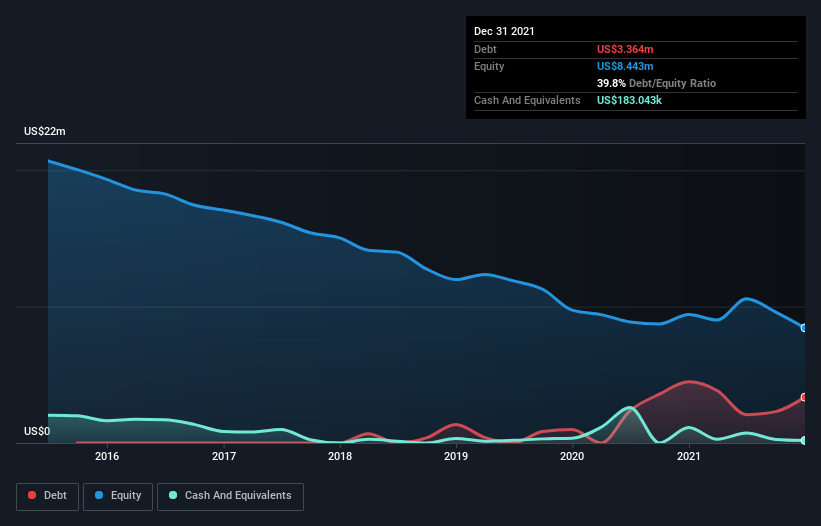- United States
- /
- Medical Equipment
- /
- OTCPK:AHPI.Q
Is Allied Healthcare Products (NASDAQ:AHPI) Using Too Much Debt?

Legendary fund manager Li Lu (who Charlie Munger backed) once said, 'The biggest investment risk is not the volatility of prices, but whether you will suffer a permanent loss of capital.' It's only natural to consider a company's balance sheet when you examine how risky it is, since debt is often involved when a business collapses. We can see that Allied Healthcare Products, Inc. (NASDAQ:AHPI) does use debt in its business. But the real question is whether this debt is making the company risky.
Why Does Debt Bring Risk?
Debt and other liabilities become risky for a business when it cannot easily fulfill those obligations, either with free cash flow or by raising capital at an attractive price. If things get really bad, the lenders can take control of the business. However, a more common (but still painful) scenario is that it has to raise new equity capital at a low price, thus permanently diluting shareholders. Of course, plenty of companies use debt to fund growth, without any negative consequences. The first step when considering a company's debt levels is to consider its cash and debt together.
Check out our latest analysis for Allied Healthcare Products
How Much Debt Does Allied Healthcare Products Carry?
You can click the graphic below for the historical numbers, but it shows that Allied Healthcare Products had US$3.36m of debt in December 2021, down from US$4.48m, one year before. However, it also had US$183.0k in cash, and so its net debt is US$3.18m.

How Healthy Is Allied Healthcare Products' Balance Sheet?
The latest balance sheet data shows that Allied Healthcare Products had liabilities of US$7.44m due within a year, and liabilities of US$29.7k falling due after that. Offsetting these obligations, it had cash of US$183.0k as well as receivables valued at US$2.41m due within 12 months. So it has liabilities totalling US$4.88m more than its cash and near-term receivables, combined.
Allied Healthcare Products has a market capitalization of US$9.27m, so it could very likely raise cash to ameliorate its balance sheet, if the need arose. But we definitely want to keep our eyes open to indications that its debt is bringing too much risk. The balance sheet is clearly the area to focus on when you are analysing debt. But you can't view debt in total isolation; since Allied Healthcare Products will need earnings to service that debt. So if you're keen to discover more about its earnings, it might be worth checking out this graph of its long term earnings trend.
Over 12 months, Allied Healthcare Products made a loss at the EBIT level, and saw its revenue drop to US$29m, which is a fall of 23%. That makes us nervous, to say the least.
Caveat Emptor
While Allied Healthcare Products's falling revenue is about as heartwarming as a wet blanket, arguably its earnings before interest and tax (EBIT) loss is even less appealing. Its EBIT loss was a whopping US$4.3m. Considering that alongside the liabilities mentioned above does not give us much confidence that company should be using so much debt. Quite frankly we think the balance sheet is far from match-fit, although it could be improved with time. However, it doesn't help that it burned through US$2.2m of cash over the last year. So in short it's a really risky stock. There's no doubt that we learn most about debt from the balance sheet. But ultimately, every company can contain risks that exist outside of the balance sheet. Be aware that Allied Healthcare Products is showing 3 warning signs in our investment analysis , and 2 of those are concerning...
At the end of the day, it's often better to focus on companies that are free from net debt. You can access our special list of such companies (all with a track record of profit growth). It's free.
If you're looking to trade Allied Healthcare Products, open an account with the lowest-cost platform trusted by professionals, Interactive Brokers.
With clients in over 200 countries and territories, and access to 160 markets, IBKR lets you trade stocks, options, futures, forex, bonds and funds from a single integrated account.
Enjoy no hidden fees, no account minimums, and FX conversion rates as low as 0.03%, far better than what most brokers offer.
Sponsored ContentNew: Manage All Your Stock Portfolios in One Place
We've created the ultimate portfolio companion for stock investors, and it's free.
• Connect an unlimited number of Portfolios and see your total in one currency
• Be alerted to new Warning Signs or Risks via email or mobile
• Track the Fair Value of your stocks
Have feedback on this article? Concerned about the content? Get in touch with us directly. Alternatively, email editorial-team (at) simplywallst.com.
This article by Simply Wall St is general in nature. We provide commentary based on historical data and analyst forecasts only using an unbiased methodology and our articles are not intended to be financial advice. It does not constitute a recommendation to buy or sell any stock, and does not take account of your objectives, or your financial situation. We aim to bring you long-term focused analysis driven by fundamental data. Note that our analysis may not factor in the latest price-sensitive company announcements or qualitative material. Simply Wall St has no position in any stocks mentioned.
About OTCPK:AHPI.Q
Allied Healthcare Products
Allied Healthcare Products, Inc. manufactures and markets respiratory products for use in the health care industry in a range of hospitals and alternate site settings worldwide.
Weak fundamentals or lack of information.
Market Insights
Community Narratives




